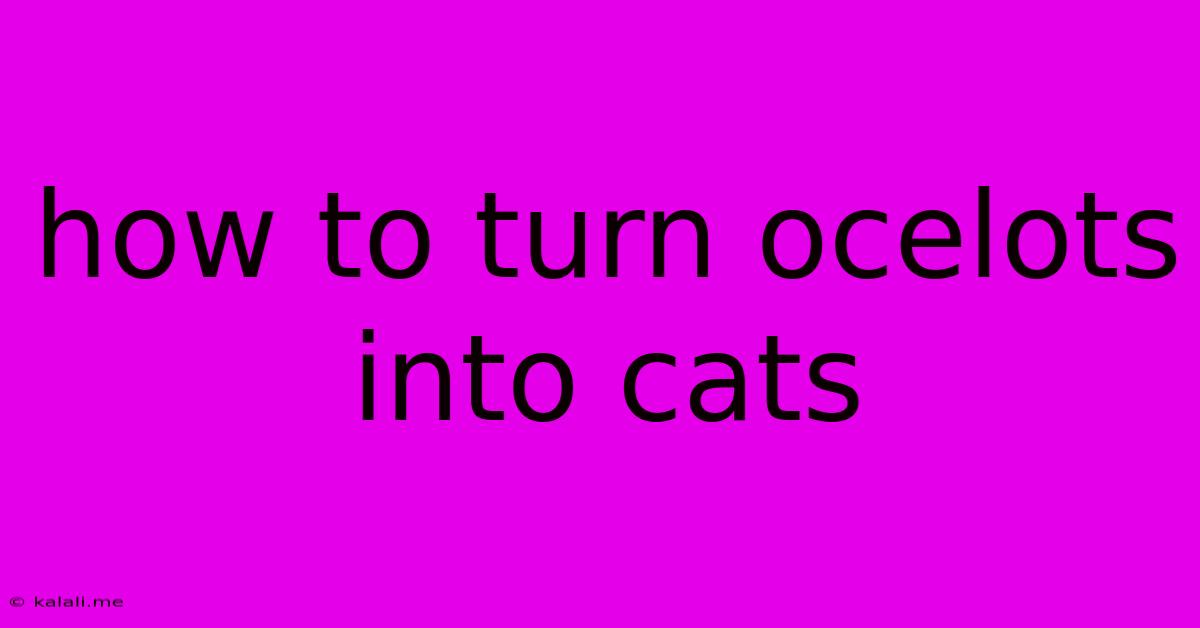How To Turn Ocelots Into Cats
Kalali
Jun 01, 2025 · 2 min read

Table of Contents
How to Turn Ocelots into Cats: A Humorous Look at Domesticating Wild Animals
This article explores the impossible task of turning an ocelot into a house cat, focusing on the inherent challenges and highlighting the importance of respecting wildlife. While the title is playful, the underlying message is serious: domesticating a wild animal is unethical and often dangerous. Let's dive into why you can't turn an ocelot into a cuddly house cat and why you shouldn't even try.
Why Ocelots Aren't House Cats (and Shouldn't Be)
Ocelots, despite their stunning beauty and somewhat cat-like appearance, are wild animals. They possess powerful instincts and behaviors vastly different from domesticated cats. Attempting to domesticate an ocelot is not only incredibly difficult but also poses significant risks to both the animal and humans.
Instinct vs. Domestication
The key difference lies in millennia of selective breeding. Domestic cats have been bred for thousands of years to be compatible with human companionship. Their behavior, temperament, and even physical characteristics have been shaped by this process. Ocelots, on the other hand, have evolved to survive in the wild. Their instincts are geared towards hunting, territoriality, and self-preservation – traits that don't translate well to a home environment.
The Dangers of Domesticating Wild Animals
- Aggression and unpredictable behavior: Even with extensive training (which is unlikely to be successful with an ocelot), their wild instincts can trigger aggressive behavior unexpectedly. This poses a serious risk of injury or even death to humans.
- Specialized diet and care: Ocelots have very specific dietary needs that are difficult and expensive to meet in a home setting. Providing adequate nutrition and veterinary care is crucial, and this requires specialized knowledge and significant resources.
- Legal restrictions: Owning and keeping wild animals like ocelots is often heavily regulated or even illegal in many countries. Attempting to do so could lead to hefty fines or legal repercussions.
- Ethical considerations: Taking a wild animal from its natural habitat causes immense stress and disrupts the delicate balance of the ecosystem. It's crucial to prioritize the well-being and conservation of wild animals rather than attempting to "domesticate" them for personal gain.
Appreciating Ocelots from Afar
Instead of trying to transform an ocelot into a house cat, let's appreciate these magnificent creatures in their natural environment. Supporting conservation efforts that protect ocelots and their habitats is a far more responsible and ethical approach than attempting to domesticate them. This includes supporting organizations dedicated to ocelot research and habitat preservation.
Conclusion:
The idea of turning an ocelot into a house cat is a fantasy. While adorable in appearance, these wild animals belong in the wild. Respecting their wild nature and supporting conservation efforts are the best ways to ensure their survival and protect both the animals and humans. Let's appreciate their beauty from a distance and focus our efforts on preserving their natural habitat for future generations.
Latest Posts
Latest Posts
-
How To Plug Big Wholes With Waterproffing
Jun 03, 2025
-
Was Does Having The Bcm Flashed Mean On A Car
Jun 03, 2025
-
How Did Xavier Lose His Legs
Jun 03, 2025
-
How To Turn On A Bicycle Light
Jun 03, 2025
-
Why Did My Ac Unit Freeze Up
Jun 03, 2025
Related Post
Thank you for visiting our website which covers about How To Turn Ocelots Into Cats . We hope the information provided has been useful to you. Feel free to contact us if you have any questions or need further assistance. See you next time and don't miss to bookmark.